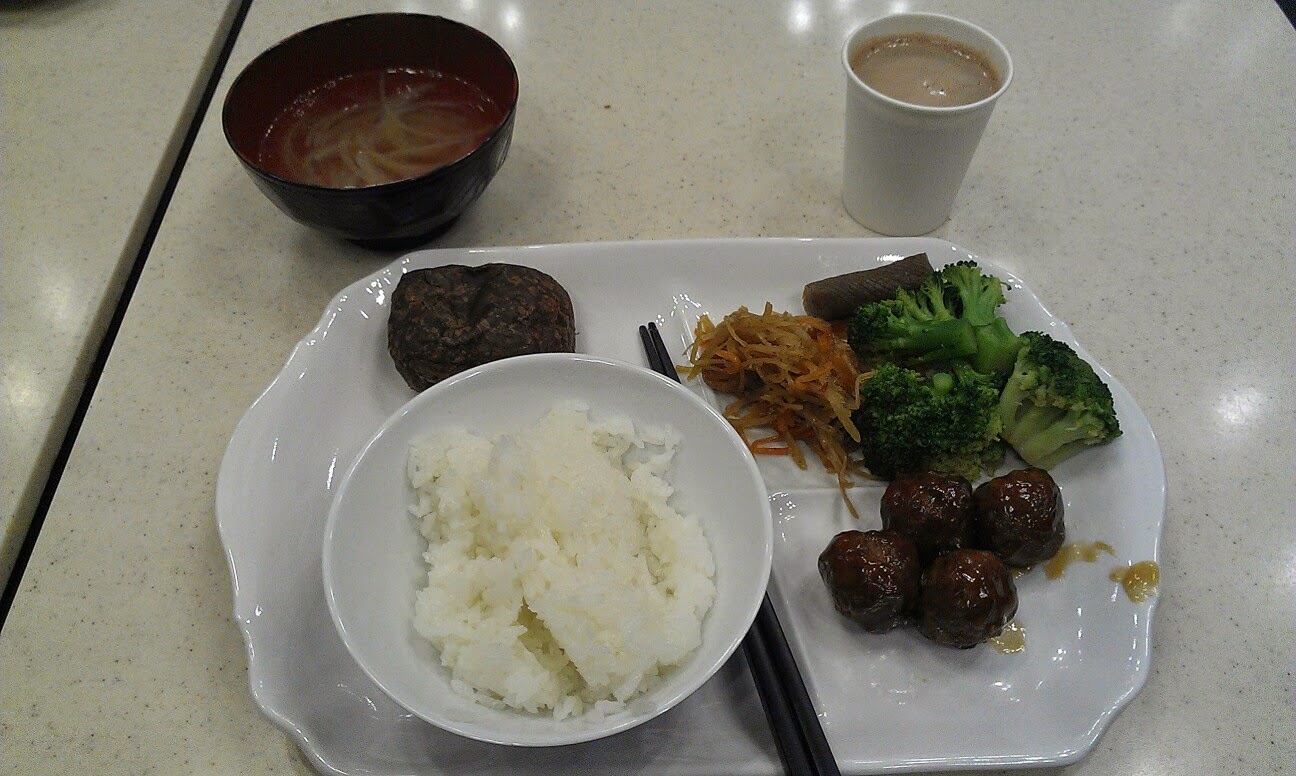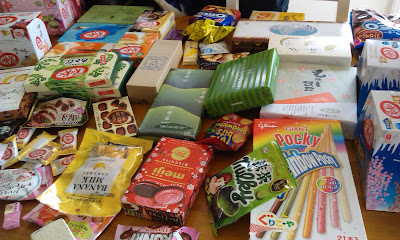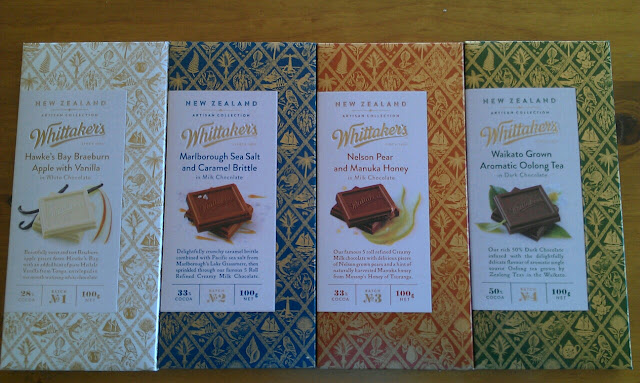Hakone: Mt Fuji, Rikyu Tonkatsu, Resorpia and Onsen
Day Three
BREAKFAST
Final breakfast in Toyoko Inn. The whole family agreed we would miss the hotel - and we did. |
| Consomme soup, hot chocolate, mini chocolate croissant, steamed rice, seasoned vermicelli, konnyaku, broccoli, and the best meatballs ever |
HAKONE
At Odawara station, we purchased the Hakone 2-Day Free Pass at ¥4000 per person, which allowed us on all trains, boats, buses, and whatever transport was available in Hakone. The destination was Gora Station, and this is where the transport becomes confusing. One platform contained a multitude of tracks all leading in different directions - for some, connecting tracks could have two different trains. In other words, it was very easy to board the wrong train (which we did). After some questioning, we managed to head in the right direction and headed for Gora Station.Hakone is situated in a mountain area which reminded my family of Rotorua. As the train went up the mountain there came a vague smell of sulphur we associated with the New Zealand city. The sights made journey relatively interesting, but it took a good part of an hour, as the train constantly had to change tracks to climb the mountain in a zig-zag pattern. Following the train ride was a tram to the hotel.
 |
| Tram tracks |
Lunch was a rushed meal of convenience-store bread and snacks bought in the station in Tokyo. Following check-in at the hotel, we headed for Sounzan, the topmost station on the tramline that took us to the Hakone Ropeway (included in the Free Pass) headed for Mt. Fuji. Initially, the ride is quite slow and boring, as most of the scenery consists of Hakone mountainside, but there comes a funny point where the ropeway surpasses a hill, giving view to Mt. Fuji that had the whole car stop to gasp, and take photographs.
 |
| Mt. Fuji |
We were particularly lucky the mountain was visible. I've been told it's often covered by clouds, or sometimes without snow, making it look lacking.
On top of Hakone mountain is a delicacy of kuro-tamago (black eggs), eggs which have been reportedly cooked on the hot springs on the mountains, and the sulphur present contributes to the black colour. It's suggested that eating a kuro-tamago will add seven years to your life, though eating more than two and a half is advised against.
 |
| Kuro-tamago black eggs |
For ¥500 for 5, the taste itself isn't anything special. Still, it's an interesting experience, and now I'll live longer.
The next ropeway took us down to a lake, where we boarded a pirate ship (included in the Free Pass).
 |
| The pirate ship |
There aren't a lot of shops at the dock, only a few convenience stores and restaurants amongst other things. By then it was late afternoon, and since a lot of transport stopped at 4:30 (that's earlier than New Zealand!) and we had no idea when the last bus to Gora station would be, we thought we'd make a move.
 |
| Oshiruko - warm sweet red bean soup drink (about ¥120-160 from vending machines). Delicious, but the bane of my existence. The red beans get stuck in the can, making for a very frustrating drink. |
We arrived back at Gora station nearing five o'clock, which was a perfect time to arrive.
DINNER - RIKYU TONKATSU
Dinner was a highly-anticipated meal at Rikyu Tonkatsu. About two minutes' walk uphill from Gora station, we lingered outside for a couple of minutes at five o'clock, unsure of whether it was open. Two people beat us to it, and two had reservations, but luck followed as the restaurant seated nine exactly, allowing us, a group of five, to be the last ones seated for the time being. |
| Rikyu Tonkatsu |
The shop is run by what appears to be a husband-wife duo. As the husband cooks the pork, the wife prepares the rest of the meal.
The menu has four items written in calligraphy on wooden boards on the cupboards. We had no idea what they were - the man asked, "pork?" to which we nodded dumbly.
I found out later that the choices were hirekatsu (pork fillet), mizorekatsu (pork fillet with grated daikon radish, spring onions, lemon, and a special sauce), nikatsu (katsu in soup), and rooskatsu, the standard pork loin set for ¥2,550, which we all received one of. Along with the 220g cutlet came the remainder of the set meal: rice, miso soup, home-made sides of fried burdock root, cold tofu, and pickled vegetables, a huge handful of sliced cabbage, and as much green tea as you like. A small plate was also given to pour out a home-made sauce for the cutlet and mustard. The chef recommends that salt is added to the pork, which brings out more of the flavour as the pork is not seasoned beforehand.
 |
| The ¥2,550 rooskatsu teishoku - pork loin set meal |
Common courtesy in Japan, especially in small establishments such as this, dictates that every bit of food is finished.
Cons:
- Probably one of the priciest meals in Japan we had (more to come, however!) at ¥2,550 a head. However, considering it was all made fresh with a huge 220g cutlet, it was a price we were prepared to spend.
- We left the place smelling of pork cutlets: jackets, sweaters, shirts, undershirts, pants and all.
Pros:
- The pork was AMAZING. Seriously good. Not a place to take children, but definitely a place to try out.
- Great Japanese experience of sitting at the counter and watching the pork being made.
- The pork was AMAZING - thicker than it looks on photo. We agreed that if we went to Hakone again we'd try the pricier pork fillet.
Score: 23/23. The smell was easily overlooked. Be warned if you arrive a bit past five - the restaurant has a big reputation, and a man arriving only a few minutes after our large group waited patiently for an hour on the seats outdoors for a place. Prepared with a book, he likely knew he may have needed to wait some time.
HOTEL AND ONSEN
We stayed in Resorpia Hotel. Though the gate entrance is right beside the tram station, there's about 50m of serious uphill, followed by a set of stairs, before you can enter the hotel itself. Having to haul luggage up the slope, as well as limited Wi-Fi areas and breakfast not included in the package, struck some points against Resorpia. However, the rooms, we found, were the largest we had in Japan, and, as I was later informed, the cheapest.
The Resorpia has two buildings connected by an underground corridor. The hotel is Japanese-style, with futons in the cupboards. We used the futons, moving aside the table and cushions. It felt like a sleeping on a hard bed with a soft duvet.
 |
| Resorpia Hotel room (another single-bed off-screen) |
Amongst the information we received when checking in to the hotel was a flyer on the traditional Japanese onsen (public hot baths). Though I was sceptical, my sisters jumped at the chance to try it, so I joined in. There was no fee to use the onsen facilities, which was an added bonus, but we had no idea what to do, but after an exchange in broken Japanese with the lady at the counter we figured the general idea: Clothes are fully removed and placed into one of the allocated cubby holes - or baskets, in our case. With the smaller of the two towels provided, we moved into the bath area, where one showers sitting down. After towelling down, soak in the hot baths for as long as desired - the onsen at Resorpia had an outdoor hot pool, which we opted for, as it was the only one occupied (at ten in the evening, we decided to follow suit of the Japanese guests in the outdoor bath). More out of awkwardness and uncertainty than disrespect, we were quite giggly, probably the cause of the two other guests leaving soon after arrival.
A sauna was also available for use. After a good soaking, we towelled off again, and discarded the towels in baskets provided, before dressing. Using the onsen was indescribably refreshing, making me feel cooled down having soaked in hot water. If there's ever a chance to go to an onsen, I would highly recommend it as both a good Japanese experience and the overall feeling after.
No photos of the onsen (for good reason).
End Day Three
A sauna was also available for use. After a good soaking, we towelled off again, and discarded the towels in baskets provided, before dressing. Using the onsen was indescribably refreshing, making me feel cooled down having soaked in hot water. If there's ever a chance to go to an onsen, I would highly recommend it as both a good Japanese experience and the overall feeling after.
No photos of the onsen (for good reason).
End Day Three




Comments
Post a Comment